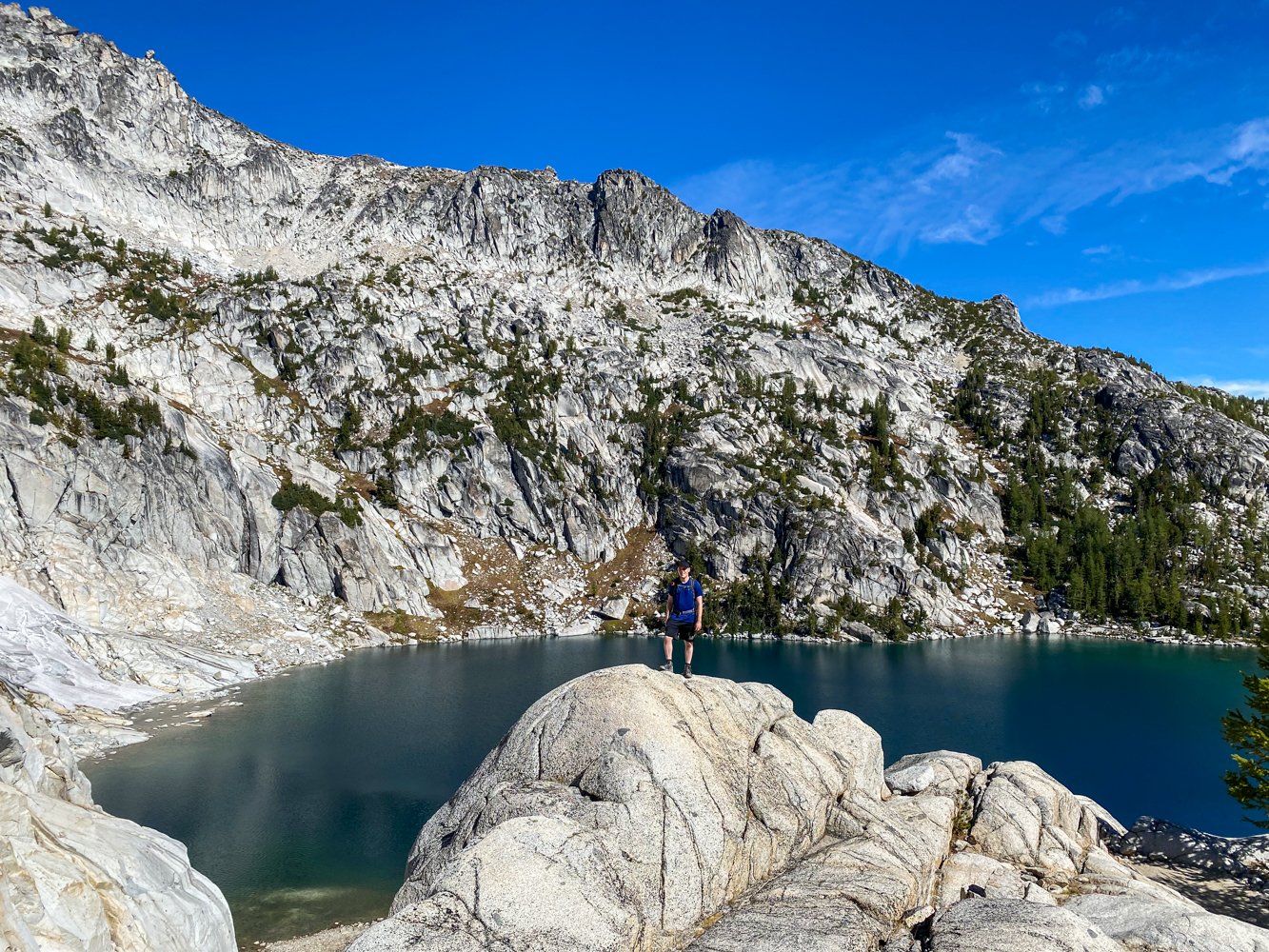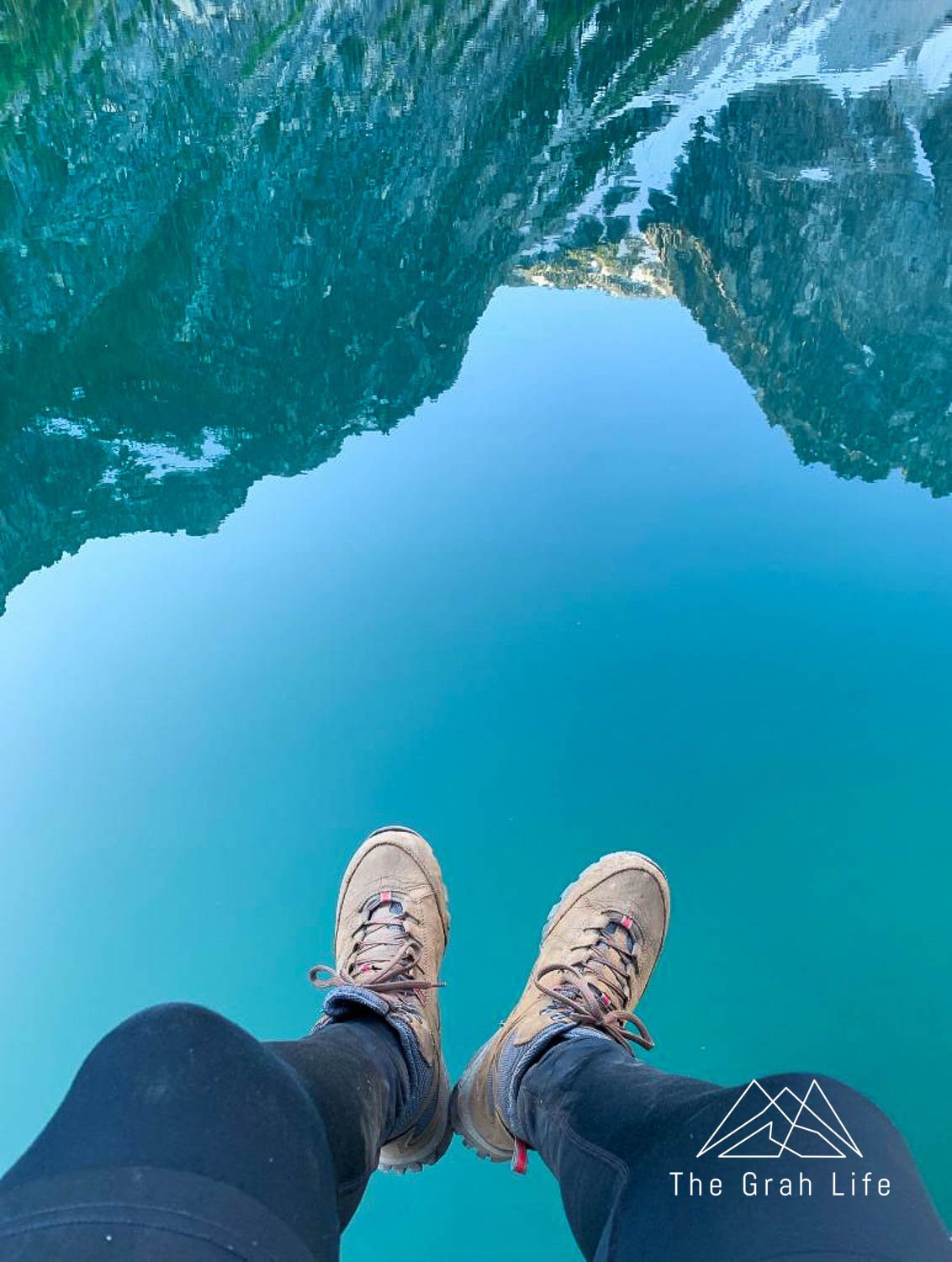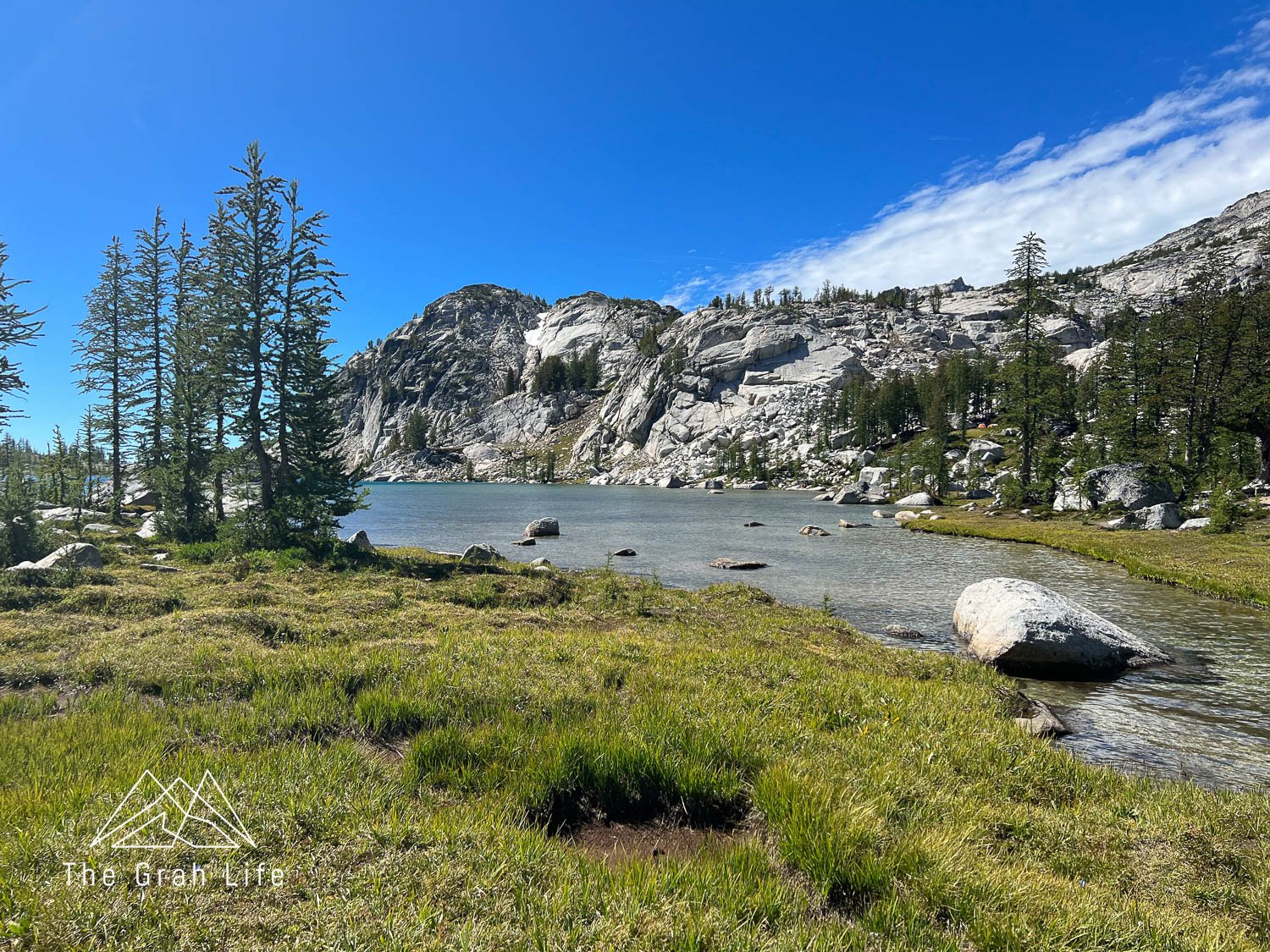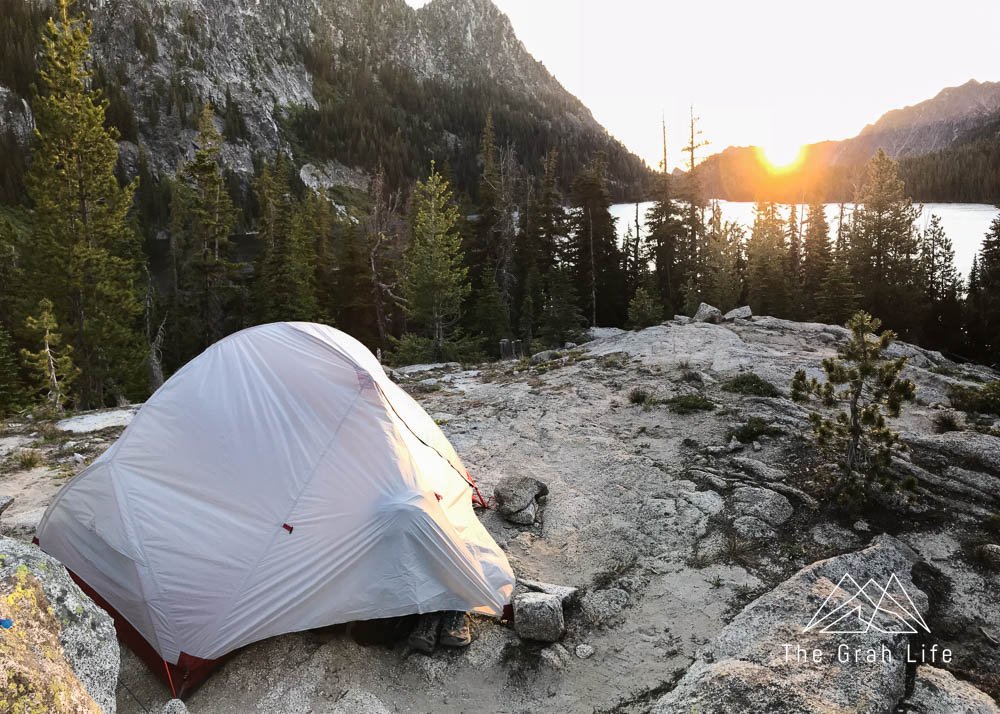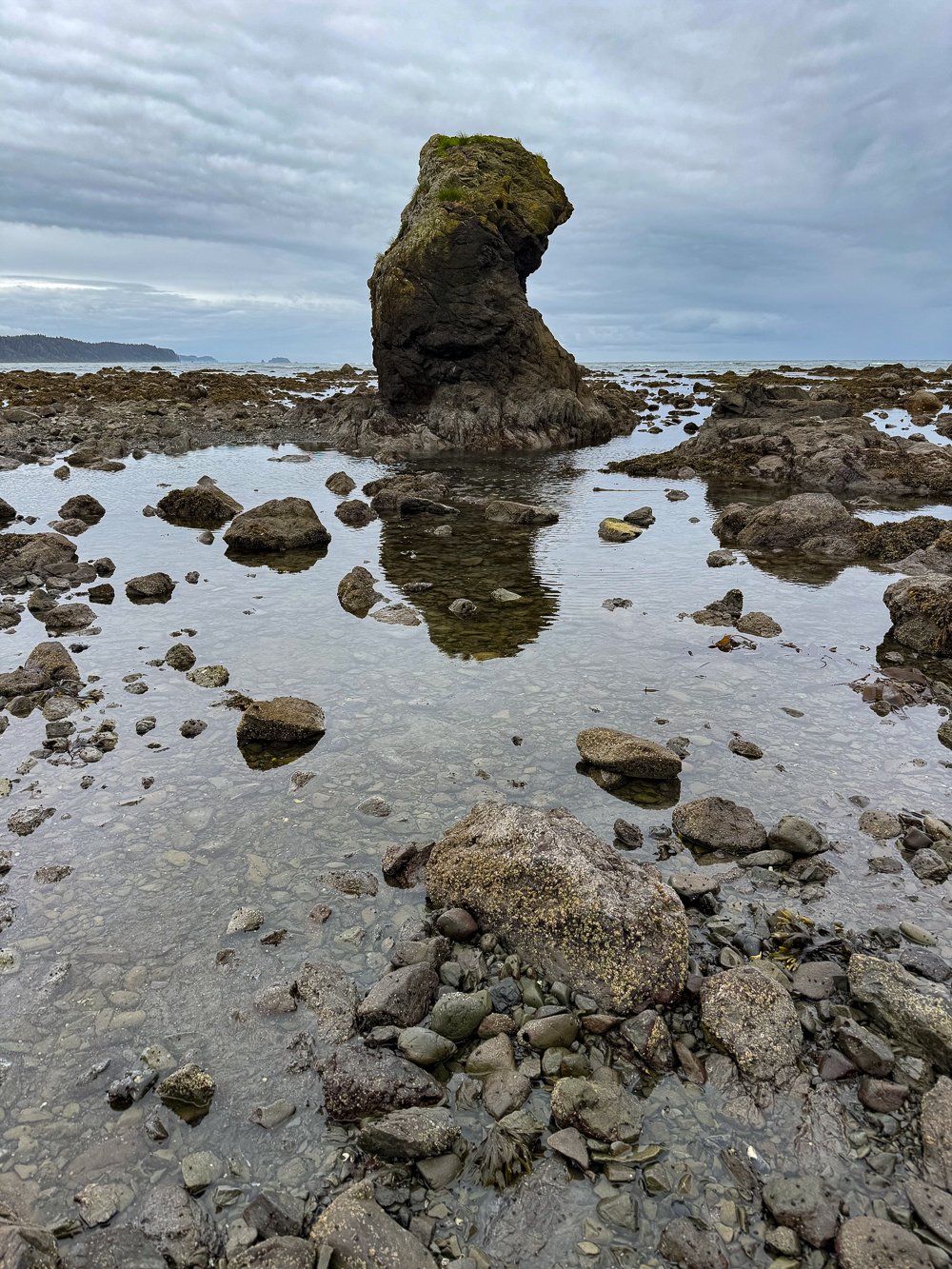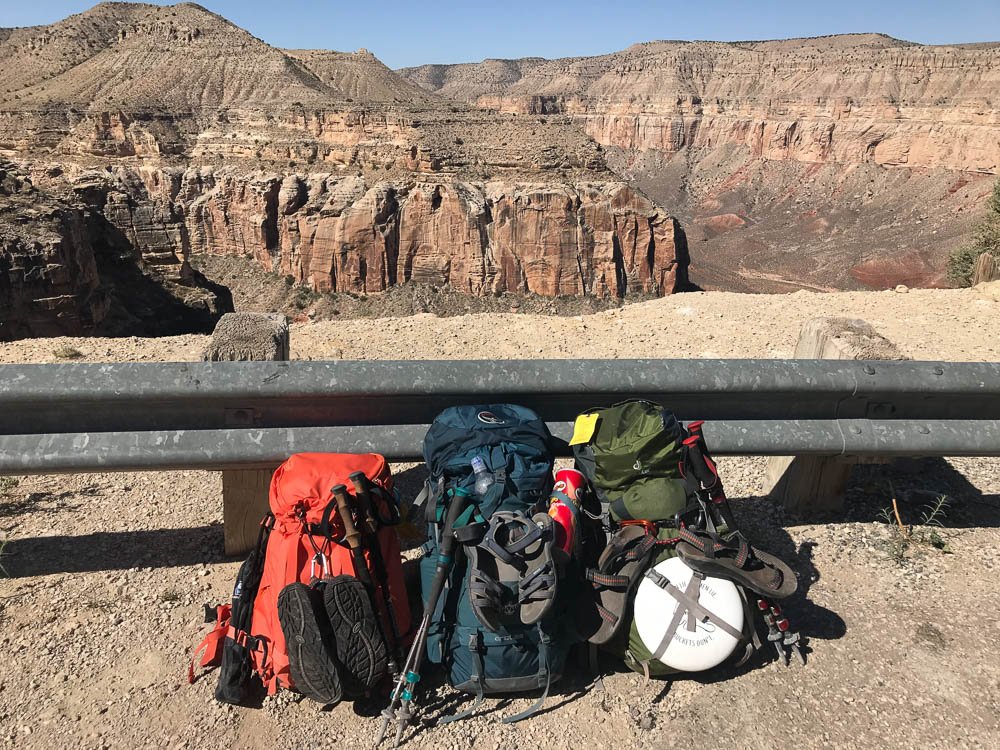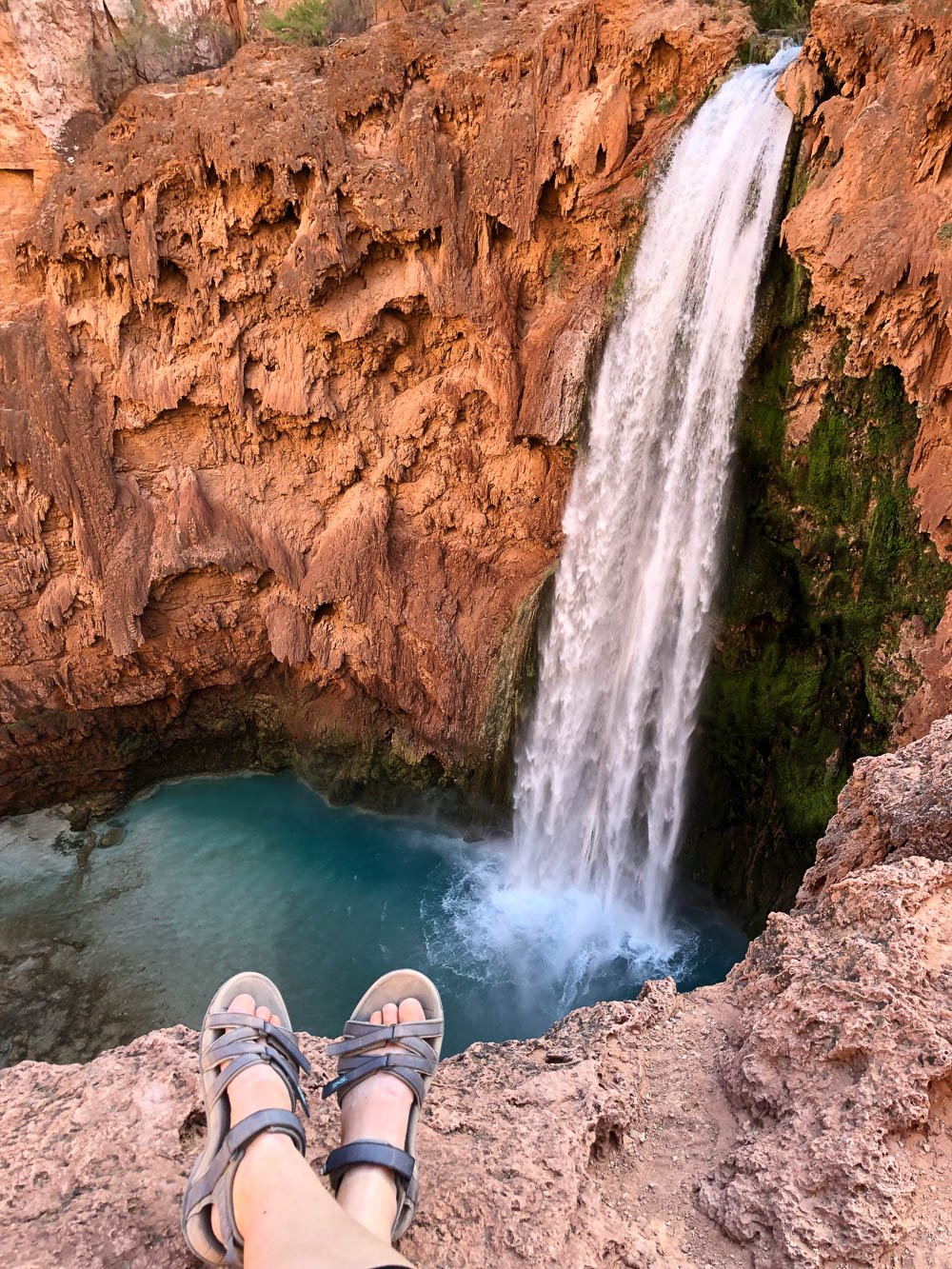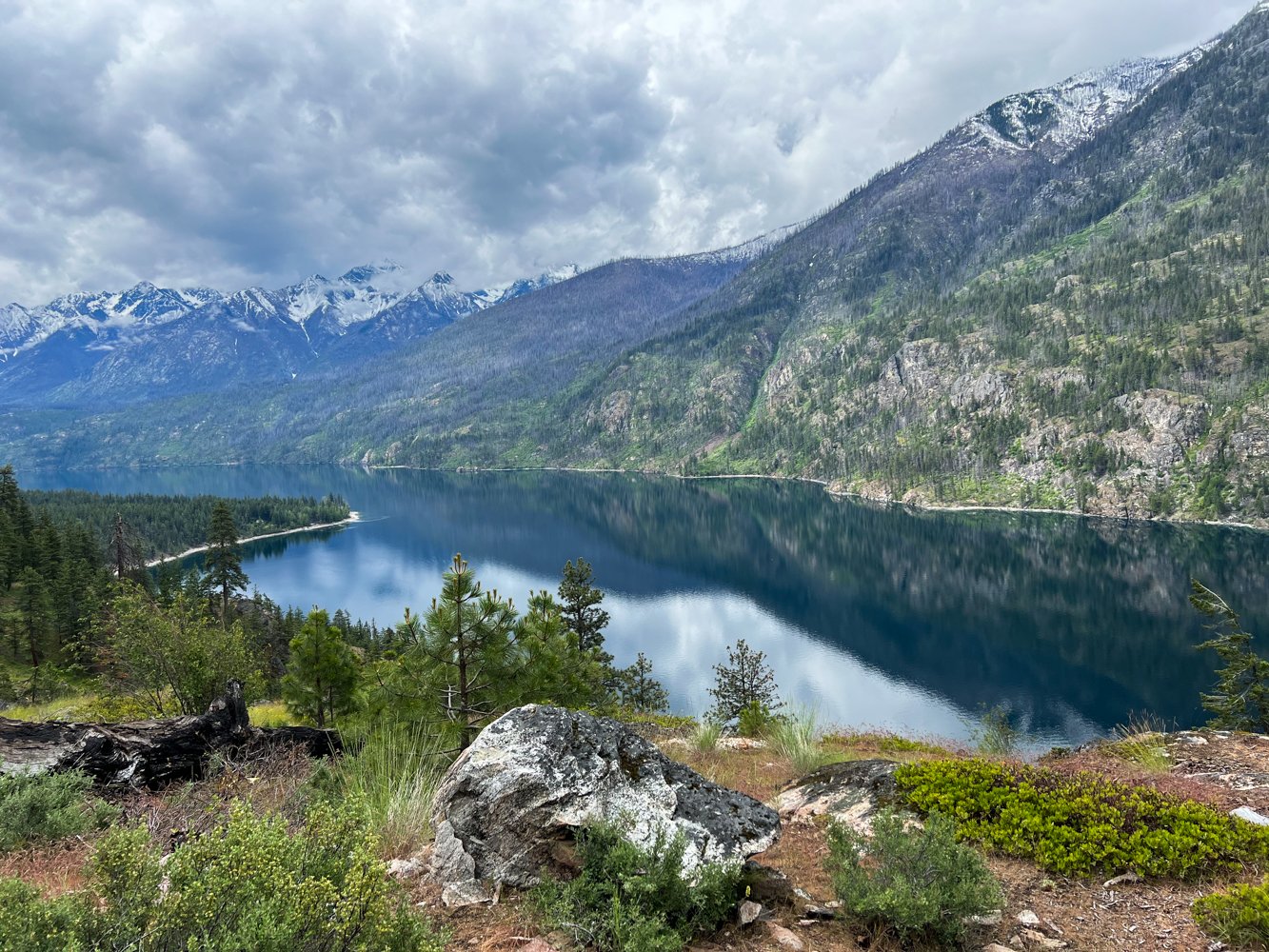How to Backpack the Enchantments in Washington
Backpacking in the Enchantments is a highly coveted privilege. It’s full of some of Washington’s best scenery, including alpine lakes, beautiful waterfalls, rugged peaks, and larches. To help preserve the environment, there is a permit lottery to backpack, and the area is regularly patrolled by rangers.
Winning permits isn’t a simple task though. Read on for information on how to apply, ideal times to backpack, and more.
What if you didn’t win a permit?
Disclosure: We’ve included affiliate links with recommended hiking gear in this post. If you click through and buy something, we’ll receive a small portion of that sale. You won’t be charged more, and we haven’t been paid by any of these retailers to share their information. These are all our genuine preferences.
Permit lottery
You can apply for permits between February 15th and February 29th here. To enter the lottery, you’ll need to select your desired dates, group size, permit zone, and pay a $6 fee. Since it’s a lottery, there is no benefit to applying earlier. You’ll have the option to select three different dates and zones, which are explained below.
Log back onto recreation.gov between March 14th and March 31st — this is when the lottery winners are announced. If you see that you’ve won a permit, you’ll need to claim your permit by confirming your entry and exit dates. You’ll also need to pay an additional $5 per person/per day for your party.
Alternate permit holders
We love that they’ve added alternate permit holders to the Enchantments lottery! In the case of the primary permit holder being unable to make their permit dates, their group can still backpack if there is an alternate permit holder listed and able to go.
Choose your alternate permit holders wisely because they will not be able to enter the permit lottery separately. They’ll also need to accept the alternate position via email within 72 hours of you applying.
Selecting an alternate permit holder is optional, but doing so can only be done during the lottery application.
How to better your odds
Your odds will differ depending on the zones you apply for, the dates, and your group size. July and August are the most popular months, with Friday selected as the most popular day to enter the Enchantments. You’ll have the best odds of winning when applying to enter between Sunday and Wednesday.
Group size can work for or against you as well. Up to eight people are allowed in one group. If you’re hoping to win permits to the Core Zone, more people in your group could be considered a disadvantage since they limit the number of permits by people. If you’re applying to other zones, a larger group could work in your favor since permits are allotted by group. Have everyone in your group apply and you could have better odds of winning.
What if you didn’t win a permit?
Unclaimed permits
Those that won permits but didn’t claim them will have them put back on sale on April 1st around 7:00 am. Log on to recreation.gov to snag one.
Walk-up lottery
One permit from each zone is reserved for walk-ins, except on Sundays. These go on sale at the Leavenworth Ranger Station in person at 8:30 am during the permit season.
Day hike
Permits to day hike are unlimited and self-registered at the trailhead. This is a great way to see a glimpse of the Enchantments. We’ve got hiking recommendations for each zone below. Just make sure to arrive early to get parking!
Thru hike
If seeing a bit of the Enchantments isn’t enough for you, try thru hiking through four of the zones. It’s a grueling 18-mile hike, but you’ll see the best of the Enchantments in one day!
Enchantment Zones
The Enchantments is split into five zones. When you apply for the permit lottery, you’ll select your first, second, and third choice of zones and dates. If you win permits for any zone but the Core Zone, you’ll only be allowed to camp in that zone.
Core Enchantment Zone
The Core Zone is the farthest area into the Enchantments. When backpacking, it usually takes two days to reach, so Core Zone permits allow you to camp anywhere in the Enchantments. Most backpackers camp at Colchuck Lake or Snow Lake prior to entering the Core Zone.
These permits are the most sought-after, and the most limited. Only 24 people are allotted permits to the Core Zone each day during the permit season. According to 2019 statistics, you’ll have a 2% chance of winning permits to backpack in the Core Zone. To put this into perspective, you have a 3% chance of winning the permit lottery to hike The Wave!
There is a downside to backpacking in the Core Zone, however. It means packing your gear up Aasgard Pass or via the Snow Lake Trail. Going up Aasgard is a tough workout without a heavy pack (read more about it here). Entering via the Snow Zone requires a longer route, and the area between Snow Lakes and Lake Viviane (the Core Zone) is also steep.
The descent from the Core Zone to Snow Lake
Colchuck Zone
Colchuck Lake is infamous in the Pacific Northwest. It’s the lake at the start of Aasgard Pass, known for its stunning view of Dragon Tail Peak and green waters. It’s possible to daytrip into the Core Zone from here via Aasgard Pass, but hiking back down is more of a chore than going up it. Permits are limited to three groups each day in this zone, and you’ll have slightly better odds (13%) of winning permits here than in the Core Zone.
Snow Zone
The Snow Zone makes for a great choice in permits because you can camp at Lake Nada or Snow Lake. Day hiking to the Core from Snow Lake is possible via a short, but steep, trail to Lake Viviane as well. We think this is one of the best ways to experience the Core Zone without having to lug a full backpack up there!
Getting permits to this zone is less competitive; five groups are allowed permits here each day during the permit season.
View of Snow Lake from above
Stuart Zone
The Stuart Zone is less competitive and popular, with four groups allowed permits each day. This is great if you want to get a permit, but reaching the Core Zone via a day trip would be a longer day starting at Lake Stuart. Instead, we recommend day hiking to Colchuck Lake.
Eightmile/Caroline Zone
Even though only three groups are allotted permits here for each day of the permit season, your odds of winning permits are the highest for this zone. Why? It’s the farthest zone from the Core Zone, making day hikes there impossible. The area is also recovering from 2012 and 2017 wildfires, but don’t let that deter you. Camp at Eightmile Lake or Caroline Lake for great views of Mount Stuart.
Best season
Backpacking in the Enchantments is seasonal and regulated by permit between May 15th and October 31st. However, the weather and conditions vary greatly during this time.
If you visit in May, you’ll be trekking through snow, especially in the Core Zone, and getting there could be downright dangerous. Choose to visit in October, and you’ll have a chance of experiencing early snowstorms, although you’ll get to see the larches turn.
For the best conditions and weather backpack here between late June and early September. However, knowing wildfire safety is important if you hike in the hotter months. We don’t advise hiking here outside of permit season.
Trail overviews
The trails outside the Core Zone are well maintained and marked. However, the approach to Aasgard Pass, the ascent up Aasgard Pass, and the entire Core Zone requires route finding. If you plan on hiking in the Core Zone, check out this blog for more information.
Aasgard Pass
Water access
You’ll have great water access in each of the zones. There are streams that flow through the area, and most campsites are near a lake.
Trip reports
To get a better sense of trail conditions for your trip, check recent trip reports for anywhere you’re considering hiking on Washington Trails Association.
The dam at Snow Lake in spring
Wildlife
Mountain goats
Goats are the most well-known animal in the Enchantments. Unfortunately, they can be aggressive. If you see them, give them plenty of space, and do not pee anywhere near them. They will charge you if you do.
Instead, use the backcountry toilets or pee when goats are out of sight on rocks. If you pee on brush instead, the goats will destroy the plants trying to get the salt from your urine.
Bears
Black bears are known to roam throughout the Cascade mountains, and the Enchantments are no exception. Talk and make noise on your hike to prevent from sneaking up on wildlife. We have yet to see a bear in this region but have passed by other hikers who have. Check this article on what to do if you encounter a bear.
Cougars
Of all the animals in the Pacific Northwest, cougars scare us the most. They prefer staying hidden and are quiet and stealthy. Sometimes they escort hikers through their territory, but attacks are rare. Again, talk and make noise throughout your hike, especially around blind corners, to prevent sneaking up on unsuspecting wildlife, and check here for more information on what to do if you encounter a cougar.
Pikas, marmots, pacific martins
It’s a treat to see each of these animals. You’ll find pacific martins amongst the forest at lower elevations, out in the mornings and evenings. Keep your eyes and ears open for the calls of pikas and marmots at higher elevations. Pikas live in the boulder fields. To spot one, be silent, slow down, or stop before entering a boulder field. Wait a few minutes and you might hear their squeaks or see a tiny mouselike figure standing amongst the rocks. Look for marmots in meadows. They’ll be screaming at one another and gathering grass.
Birds of prey
Each time we’ve day hiked to Colchuck Lake we’ve had the pleasure of watching an eagle catch its breakfast from the lake. Mature eagles have white heads and tail feathers, but adolescents are completely brown. If you see a large bird without the coloring of an eagle, it could be an adolescent bald eagle, a hawk, or an osprey.
Ptarmigans
The white-tailed ptarmigan is only found in the Cascade Mountains in Washington State and British Columbia. Their plumage changes seasonally, and they only live in high elevations. We have seen one in the Core Zone on each of our thru-hikes, and we’ve nicknamed them alpine chickens. They have such fantastic camouflage that they nearly blend into the granite rocks.
Climate change is threatening their population, so if you see one, you can report details here to help conservation efforts.
Leave no trace
The Enchantments have a highly sensitive ecosystem. Following the Leave No Trace Principles is essential to its survival and continued recreation of the area. You’ll need to follow the usual rules of staying on trails and respecting wildlife, as well as a few other things to note.
No dogs allowed
First, keep your dogs (and horses, llamas, and pack animals) at home. They were once allowed, but aren’t any longer to help protect the ptarmigan populations.
Toilets
Use the provided toilets along the trail as much as possible. You’ll be able to find signs for toilets in each zone.
If you need to pee where there isn’t a toilet nearby, pee on rocks and hard surfaces so the goats don’t disrupt the vegetation to get the salt from it. If you need to poop without a toilet around, you’ll need to use a wag bag and pack it out.
Campsites
Campsites are FOUND, not made. Only camp in pre-existing campsites.
Route finding
Staying on trails while route finding can be tricky but do your best. There are poles that mark the route and large stacked cairns to lead you throughout the Core Zone, but there will still be times that you may choose paths that don’t work out. If a trail gets very narrow or seems to end, turn around and go back the way you came to find a better route.
Garbage
Just like anywhere else, you should pack out your trash. Keep a Ziploc bag with your food stash — they make for great trash bags, and your snack wrappers will be most of your trash.
Do not litter biodegradable items, such as orange peels or apple cores, either. It can take as long as seven years for an orange peel to decompose!
Campfires
Fires are not allowed above 5,000 feet throughout the Enchantments or within ½ mile of any lake, but you can use propane-fueled camp stoves.
Getting there
The nearest major airport to the Enchantments is Seattle-Tacoma International Airport (SEA). You can choose to fly there and drive two and a half hours to Leavenworth or catch a transfer to the Wenatchee airport (EAT), which is only a 30-minute drive from Leavenworth. From Leavenworth, it’s a 35-minute drive to reach the Enchantments.
Parking
You’ll receive an overnight visitor parking pass if you win permits to backpack the Enchantments. Carpooling is best here, but if you have others in your group driving separately, they’ll need a Northwest Forest Pass or an America the Beautiful Pass in order to park. Purchase these ahead of time online or in Leavenworth at Der Sportsman. Arrive at 7:00 am or earlier to get a parking spot.
What to pack
Hiking gear
Backpacking backpacks
Zach has Baltoro 75L bag
Meghann has the Osprey Ariel 65L
The larger your bag, the more items you’ll want to bring, so resist the urge to pack your bag full.
We highly recommend trying on packs at REI. They’ll help you load them with weight, teach you how to adjust the bag, and find the appropriate size for your torso.
Rain cover for your backpack
Some packs have this built-in, so make sure yours doesn’t before you make an unnecessary purchase.
A plastic poncho or garbage sack works in a pinch.
These help to keep your balance and keep weight off your knees, which is especially helpful while backpacking, and hiking, downhill.
Sleeping
Backpacking tents are small, and there likely won’t be enough room inside for you and your backpack. Fit your backpack in the vestibule (the space between the tent and the rainfly) instead.
This protects the bottom of your tent, especially when you’re on granite or other hard surfaces. It’s a must for us!
You can find a rock to hammer in tent stakes, but we prefer using a lightweight hammer.
Sleeping bag
The bags we have are no longer being sold, but these are the ones we’d get if we had to make another purchase (men’s/women’s)
Pay attention to the size of bags before buying — if you’re taller, opt for a bag that comes in a long size.
If your bag doesn’t come with a stuff sack to transport it in while backpacking, you’ll need to buy one — trying to stuff it in your backpack without one is impossible.
Sleeping bags aren’t unisex — women’s bags tend to have more room for hips, with more down filling in areas like the foot box where women generally feel colder than men.
Sleeping pad
These aren’t just to keep you comfortable while sleeping on the ground – they’ll help keep you warm, too.
The R-Value tells you how insulated a sleeping pad is. The scale ranges from 1.5 to 7. We recommend getting one with a rating between 3 and 5 so you’ll sleep comfortably between spring and fall (the higher the number, the more insulated it is).
We love how comfortable blow-up and self-inflating sleeping pads are, but they weigh a bit more.
For harder trips, we bring lighter (and less comfortable) Therm-a-Rest Z Lite sleeping pads. They’re great to pull out of your tent to use as a seat at camp as well.
Camp kitchen
Bear vault or food hang bag and 50’ nylon cord
Bears aren’t a huge concern in the Enchantments, but you will need to protect your food against smaller critters like chipmunks.
If you’ll be backpacking in the Core Zone, bring a bear vault because there are not many trees.
Jetboil
This Jetboil makes heating water so easy.
It has an igniter built in and comes with a pot to heat water, a lid/strainer, and a measuring cup/bowl.
There is a heat indicator on the side that begins to turn orange when it starts to get hot. The more orange you see, the hotter it is, making it easy to heat water to an appropriate temperature for hot cocoa, coffee, or a meal (pictured below).
Add this French press to your kit if you’re a coffee drinker!
The MSR Pocket Rocket Stove Kit offers a cheaper cooking solution.
This one does not have a built-in igniter, so you’ll need to bring a lighter with you.
Propane
Many backpackers prefer using these smaller fuel canisters, however, we’ve only found them online and at REI.
These canisters are easier to find, slightly larger, and only weigh 0.4 ounces more, so on easy trips, we usually take one of these and they last for multiple days.
We leave this out on hard trips (we aren’t coffee drinkers) but it’s a necessity for some!
Utensils
We love these long sporks — they’re perfect for reaching the bottom of rehydrated meal bags.
Make sure to always wash dishes 200 feet from water sources!
These are handy for drying dishes.
Sponge or dish scrubber
Dish scrubbers like these would work well, but we’ve always just cut off a strip of sponge we’ve had at home.
Gallon Ziplocs for your garbage
Food
If you use prepackaged dehydrated meals, you won’t need any dishes to cook in (aside from the pot that comes with your Jetboil or Pocket Rocket kit).
This makes washing dishes extra easy — leave out your pot of water to dry and all you’ll need to clean is your silverware.
Extra days’ supply of food.
Salt pills (caffeinated/noncaffeinated)
More on what we eat here.
Water
We have two filters:
To use, all you need to do is fill the dirty water bag with water and place it above or uphill from the filter and clean water bag — no manual labor and minimal time required!
The dirty water bag provides a great container to gather and dump water onto campfires without contaminating your drinking water vessels.
Easy to keep clean at camp and clean up for storage after you get home.
Over the years we’ve tried Osprey, Platypus, and HydraPak water bladders. The HydraPak design is best!
They’re made of tough material, so we’re not worried about them leaking or breaking, and they can be flipped inside out to clean and dry.
A water bottle is nice to have around camp, but unnecessary.
Clothing
Packable puffy coat (men’s/women’s)
Sandals to cross the dam at Snow Lakes (men’s/women’s)
Any lightweight, waterproof sandal or Crocs will do.
Dry your feet off well to prevent blisters
You’ll need this for the water crossing if you’ll be passing Snow Lake and whenever you choose to dip in a lake.
Neutrogena Ultra Sheer SPF 70 Sunscreen
This sunscreen has the safest product rating for sunscreen on the EWG’s Skin Deep guide.
Warm hat, gloves, and more layers if you’ll be hiking in the early spring or fall
Base layer tops (men’s/women’s)
Base layer bottoms (men’s/women’s)
These help to give you traction and keep you from slipping on hard packed snow and ice.
Toiletries
Toilet paper or a Kula Cloth
There are backcountry toilets in every zone. Use these when you can, pee on hard surfaces, or use a wag bag.
This is a game-changer for the women/trans/non-binary folk! It allows you to go pee standing up. Since you only have to unzip and point the direction you want to let things flow, it’s so much more private than pulling down your pants and squatting.
Either use a wipe or face wash to clean your face each night.
Use this anywhere to prevent chafing.
Zach attracts mosquitos like you’ve never seen, and this spray works just as well as 90% Deet.
The mosquitoes are worst in July and August.
The ten essentials
Don’t forget to add your own personal medications like inhalers or epi-pens.
When we got serious about backpacking, we invested in this personal locator beacon. It gives us peace of mind with the ability to set waypoints, text others when there is no cell service, and use the S.O.S button for emergencies.
There is a $14.95 monthly subscription fee
Remember to bring backup batteries.
Neutrogena Ultra Sheer Sunscreen
This sunscreen has the safest product rating for sunscreen on the EWG’s Skin Deep guide.
We recommend slipping a few of these in your bag throughout wildfire season.
Optional gear
We have two of these: one to pack our clothing in and one for food if we’re not using a bear vault.
One for clothing which doubles as a pillow.
These are nice to have if it’s cold or dusty.
Gaiters
Meghann wears these lightweight gaiters year-round — they help keep pine needles out of your boots!
These luxury items
Search the blog for more adventures! Try searching for topics such as “hiking”, “waterfalls”, or “Arizona”.


